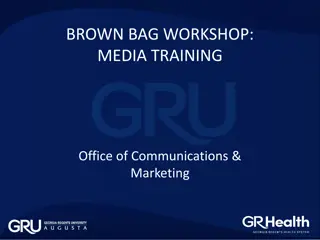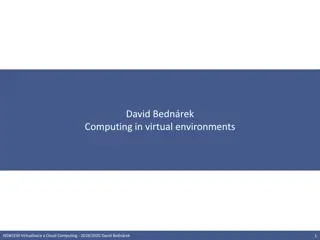Innovative Tools for Creating Virtual Galleries and New Media Art Projects
Explore the intersection of real and virtual worlds through the innovative use of panoramic images, live video interfaces, and computer vision technology. The Computer Vision Laboratory at the University of Ljubljana presents a range of projects enhancing the virtual gallery experience, including tools for web live video systems, new media production, dynamic anamorphosis, and adaptive digital signage. Learn about the Slovenian Virtual Gallery and the tools available for creating web content, such as Drupal, Joomla, Typo3, and WordPress, highlighting their advantages in flexibility, extendibility, and open-source nature. Discover how these tools enable customization without extensive programming skills, offering template systems for easy website arrangement.
Download Presentation

Please find below an Image/Link to download the presentation.
The content on the website is provided AS IS for your information and personal use only. It may not be sold, licensed, or shared on other websites without obtaining consent from the author.If you encounter any issues during the download, it is possible that the publisher has removed the file from their server.
You are allowed to download the files provided on this website for personal or commercial use, subject to the condition that they are used lawfully. All files are the property of their respective owners.
The content on the website is provided AS IS for your information and personal use only. It may not be sold, licensed, or shared on other websites without obtaining consent from the author.
E N D
Presentation Transcript
New Media Art Projects, Panoramic Image and Live Video as Interface between Real and Virtual Worlds Computer Vision Laboratory, Faculty of Computer and Information Science, University of Ljubljana DESIDOC Journal of Library & Information Technology, Vol. 34, No. 2, March 2014, pp. 110-124
Outline The improvement of the virtual gallery Introduction Tools for creation of web Live video system (LVS) New media production 15 Seconds of Frame Smart Wall Virtual Skiing and Dance Dynamic Anamorphosis Adaptive digital signage
Introduction A overview of work related to art presentation and production of new media in the Computer Vision Laboratory at University of Ljubljana.
Slovenian Virtual Gallery Slovenian Virtual Gallery, also called SVG and developed in the first half of 1995, is one of the first virtual gallery.
Slovenian Virtual Gallery (cont.) SVG supports search of authors or works of art by using different keys (name, years, art techniques).
Tools for creation of web There are four tools mentioned in the paper, including Drupal, Jooma, Typo 3, and Wordpress. All of them are open source content management system (CMS) and free for use and .
Tools for creation of web (cont.) The following are some advantages of all of them, Flexibility and Extendibility Rich plugin architecture Open source Do not need much programming skill However, for more advanced customisation, we can try to edit the PHP and HTML code.
Tools for creation of web (cont.) Both Typo 3 and Wordpress have template system, and it let customs arrange the website more easily. Typo 3 supports many platforms, such as Linux, Microsoft Windows, OS/2, and Mac OS X.
Live video over the Internet In 1996, system for active remote video observation over the internet which was named Internet Video Server (IVS) was developed by author.
Live video over the Internet (cont.) From the current position of the IVS platform, however, a web user could receive live video as well as control the camera to observe not only the sterile static exhibition, but also the visitors moving through the gallery.
New media production ArtNetLab teams up fine-art students with computer science students to produce art projects involving internet, new media, interaction and other new information technologies.
15 Seconds of Frame In the future everybody will be famous for 15 minutes ------ Andy Warhol The selection by chance out of all people in front of the installation allude that frame tends to only short-lived but also random.
Smart Wall The main goal of the Smart Wall project is to provide a platform for a rapid prototyping of computer supported interactive presentations that sense human motion.
Virtual Skiing Sporting games in general are an attractive area for using virtual technology. Real-time interaction of people with virtual environments is a well-established concept but finding the right interface to do it is still a challenging task.
Virtual Dance The Virtual Dance project presents a system that is able to track dance movements and integrates the motion in an interactive video. Dancer can produce a brand new story and movement in the virtual world.
Dynamic Anamorphosis The concept of dynamic anamorphosis can be defined as a classical or static anamorphic image requires a specific, usually a highly oblique view direction, from which the observer can see the anamorphosis in its correct form. Wherever the observer moves, he sees the same image.
Adaptive digital signage Due to larger size, better quality and lower cost digital flat-panel displays are slowly replacing static displays in commercial and public use.
Conclusions Several art-related websites and art installations, ranging from classical presentations of picture galleries to interactive art installations using computer vision have been built in cooperation with the new media artists. Contemporary arts interact with science and technology in many ways.
Conclusions (cont.) New media art projects offer a stimulating environment to experiment freely so that a new generation of artist-researchers and researcher-artist can emerge which will hopefully develop meaningful art for our times and set new agendas in science and technology that address today s real human needs.
Conclusions (cont.) New educational programs are sorely needed to combine the knowledge of technology with design skills.























